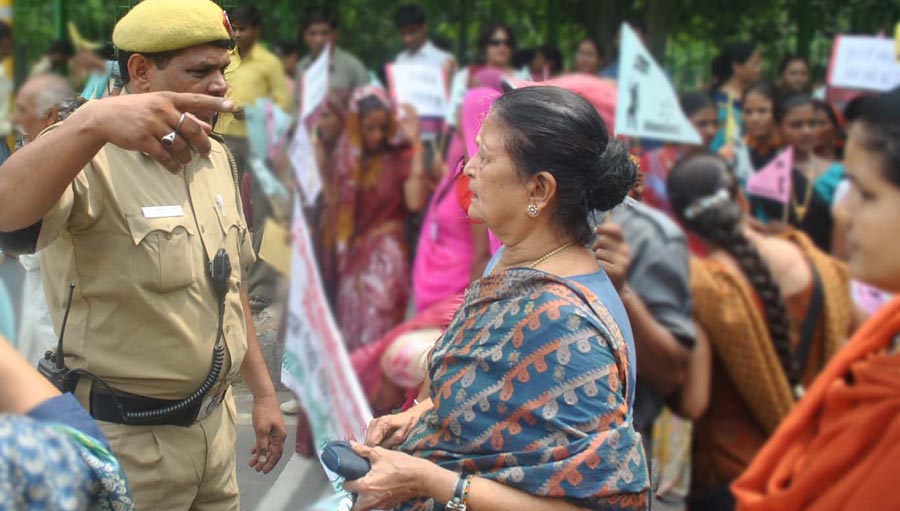Aaj kal ki ladkiy anitni besharam ho gayi hain; kahi bhi jaa ke kuch bhi bol deti hain” (Today’s girls are so shameless; they say anything anywhere). This conversation between two elderly women on my way to my destination at a West Delhi metro station still counts as an unpleasant memorabilia. However, some of my relatives and friends have chosen to taken a supercilious approach to interpretation of similar statements, maliciously dismissing them as they prefer to call it, “signs of a low mentality” totally negating the strength of its essence in shaping today’s society. It is true that the overall attitude of the majority of people in society with their misogynistic bent results from rating the virtues of women by their fidelity towards the assigned structural space. An act of violence towards women in the form of sexual, physical and emotional harassments is often justified as a response to their contumacity. Any form of visibility or participation in public arena often serves as an invitation for such harassments. One of the discernibleareas in which their act of rebellion against the dominant force of patriarchy is challenged is participation in public protests.
In India, it is not uncommon to see young girls’ and women’s involvement in protests and demonstrations. Rather, they are expected and often encouraged to raise their voices against their potential opponents. However, reasons for and the manner of criticisms towards the ‘targeted sexes’ vary depending on their respective gender status. For instance, while the opponents castigate the male protestors for taking a different political or ideological stand than their own, criticisms towards the female protestors surround their opposing ideological position interspersed with their willingness in discarding the designated roles carved out for them.Sometimes, participation in demonstrations, sloganeering during demonstrations etc. for women requires societal approval that functions in cahoots with the demands and ideals of patriarchy. Various terms used to refer to women who refuse to subscribe to these demands- besharam (shameless), badtameezladki (a woman devoid of civility) and anaaritvata (a woman without femininity) constituting some of the common insulting terms. In some cases, humiliations are also meted out to men who ‘allow the women of their households’ to sit on the streets ‘like men’ and raise bold slogans. As a result, the fear of this metaphorical emasculation that stems from ‘allowing women’ to ‘act like a man’ creates hindrances for them in reclaiming their position in public spaces.
“Women only have themselves to blame if they venture out at night and attract the unwanted attention of others”- Mukesh Singh, one of the convicts in Delhi gang rape
“Ekhaath se taalinahibajti” (It takes two to tango) – anonymous individual interviewed to speak on India’s rape culture
The manifestation of a rigid patriarchal mindset is clear from the aforementioned statements. Such thinking trenchantly condemns women’s access to make their presence physically in a public space, in addition to voice their opinions could be perceived in two areas. First, the decision makers of a quintessential orthodox Indian household; the bearers of patriarchal ideals contain the female members to step out at night for fear of getting sexually harassed, molested or raped that materializes the condonement of the highest form of sexist brutality. “sabhyagharkiladkiyaanraatkobahaarnahinilkalti” (girls of decent families do not go out at night) is a statement commonly adopted by family and household patriarchs that inadvertently equates women’s freedom with family dishonor. Thus, interplay of patriarchy is observed in restricting women to a designated ‘space’ (in this case, household) enveloped in providing justifications for their ‘protection’ as well as ‘violence committed against them’. Here, mere presence of women is interpreted as their attempts at raising their voice/ protesting against their authorities. This placement of women at the receiving end of infantilizing and gaslighting poses a major threat to their empowerment depriving them of their right to education in numerous instances and leads to increasing violence against them even within their households, the structure designed to ‘save them’.
Within the similar structured spaces, the expectation from women amounts to that of compliance and obedience. A virtuous woman in a family is either assertive of her identity as a mother, wife and a daughter imposing her gender roles and identities on the members of her own sex or accepting the same without question, doing which would make label her ‘an aberration’ subjecting her to ostracisms and domestic violences of varying nature. Thus, for women in various spheres of their collaboration and interaction in society, castigation with regard to being ‘opinionated in their own right’ supersedes promulgation of the demands of the dominant norms. Here, it is clear that the problem does not surround the notion of protests. The kinds of protests by women that invite chastisement are those that trespass the validation of the authority. Even the female protestors and their voices are contained and modified within the broader fold of patriarchy and ongoing misogyny.
In contrast to men, protests acquire a different meaning for women. In addition to defining it as a sign of expressing opposition to a differing ideology; the said opposition must fulfill its obligations to the dominant behaviour and its expectations that regards the very ‘differing ideology’ as unscrupulous. The manner, discourse and language of protests for women are defined by the dominant power, protesting against which places them at the end of assaults and opprobrium.





